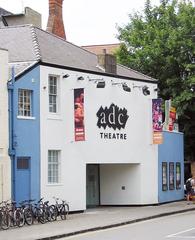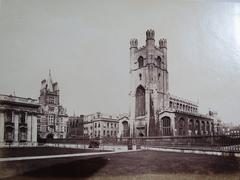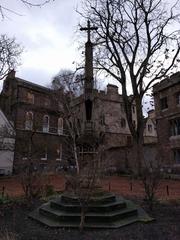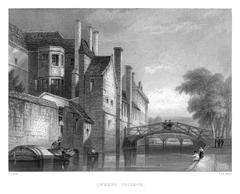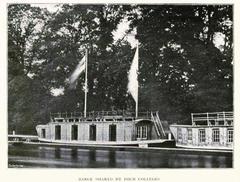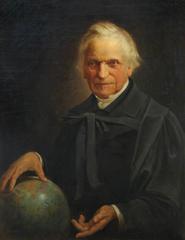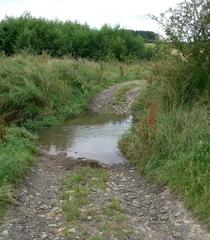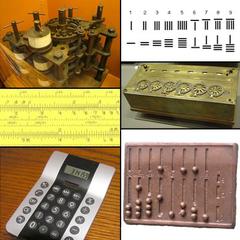Museum of Archaeology and Anthropology Cambridge Visitor Guide
Date: 31/07/2024
Introduction
Discover the rich tapestry of human history and culture at the Museum of Archaeology and Anthropology (MAA) in Cambridge. Established in 1884, this museum is a treasure trove of archaeological and ethnographic artifacts that span over two million years, offering invaluable insights into diverse cultures from around the globe. Located at the University of Cambridge, the MAA has become a cornerstone for the study and appreciation of human history and anthropology, making it a must-visit destination for scholars, students, and the general public alike (source) (source).
The museum’s collections were significantly bolstered by early contributions from notable figures such as Alfred Maudslay and Sir Arthur Gordon, and expeditions like the 1898 Cambridge anthropological expedition to the Torres Strait led by Alfred Haddon and W. H. R. Rivers. These contributions laid a strong foundation for the museum’s ethnographic collections, which now include notable items such as the earliest African stone tools and tattoo instruments collected during Captain Cook’s voyages to the Pacific (source) (source).
Over the years, the MAA has not only expanded its collections but also its reach, forming international partnerships and engaging with local communities and schools. The museum’s commitment to accessibility and its extensive range of temporary exhibitions on diverse themes highlight its role as a dynamic and inclusive institution (source). Whether you’re interested in the Anglo-Saxon Trumpington Bed Burial, the Gweagal Spears, or the museum’s various educational programs and guided tours, the MAA offers a comprehensive and enriching experience for all visitors.
Table of Contents
- Introduction
- History of the Museum
- Modern Era and Exhibitions
- Collections and Highlights
- Visitor Information
- Community Engagement and Global Reach
- FAQs
- Conclusion
History of the Museum
Founding and Early Years
The Museum of Archaeology and Anthropology (MAA) at the University of Cambridge was founded in 1884, initially known as the Museum of General and Local Archaeology. The establishment of the museum coincided with a period of burgeoning interest in archaeology and anthropology, driven by the expansion of European empires and the subsequent fascination with global cultures and histories (source).
The museum’s initial collections were significantly bolstered by contributions from the Cambridge Antiquarian Society, which provided local antiquities. Additionally, notable figures such as Alfred Maudslay and Sir Arthur Gordon donated artifacts from Polynesia, enriching the museum’s early holdings (source).
Key Contributions and Expeditions
Anatole von Hügel, the museum’s first curator, played a pivotal role in shaping the museum’s collections. Von Hügel himself donated a substantial collection of artifacts from the South Pacific, reflecting his extensive fieldwork in the region. His contributions laid a strong foundation for the museum’s ethnographic collections (source).
The museum’s collections were further expanded through the 1898 Cambridge anthropological expedition to the Torres Strait, led by Alfred Haddon and W. H. R. Rivers. This expedition was instrumental in bringing back a large quantity of materials, significantly enhancing the museum’s holdings (source).
Growth and Development
Over the years, the MAA has grown to house an impressive array of artifacts from around the world. The museum’s collections now include archaeological and ethnographic artifacts from diverse cultures, spanning two million years of human history. Notable items in the collection include the earliest African stone tools, tattoo instruments collected during Captain Cook’s voyages to the Pacific, and the Trumpington Cross, an early Christian brooch found in an Anglo-Saxon burial (source).
The museum’s location on the University of Cambridge’s Downing Site, at the corner of Downing Street and Tennis Court Road, has made it an accessible and prominent institution within the university and the broader community. In 2013, the museum underwent a major refurbishment, which included the creation of a new public entrance directly onto Downing Street, enhancing its accessibility and visitor experience (source).
Modern Era and Exhibitions
In recent years, the MAA has continued to evolve, presenting major temporary exhibitions on a variety of themes, including the body, the archaeology of childhood, and Indigenous modernist art. These exhibitions have highlighted the museum’s commitment to showcasing diverse cultural narratives and promoting a deeper understanding of human history and cultural diversity (source).
The museum has also been active in forming international partnerships and engaging with local communities and schools. This engagement has included collaborations with Indigenous communities and the presentation of exhibitions on Indigenous India, Fiji, and Mongolia (source).
Collections and Highlights
The MAA’s collections are renowned for their breadth and diversity. Among the museum’s most notable artifacts are the skeleton of a Roman woman, which inspired Sylvia Plath’s poem “All the Dead Dears,” a 14-meter tall totem pole from the Queen Charlotte Islands in Canada, and samurai armor from Japan complete with a mustache made of boar’s bristles (source).
The museum’s collections are not only significant for their historical and cultural value but also for their role in ongoing research and education. The MAA is a hub of archaeological and anthropological research, attracting scholars, students, and enthusiasts from around the world. The museum’s commitment to research is further evidenced by its Digital Laboratory, launched in 2022 (source).
Visitor Information
Accessibility
The MAA is dedicated to ensuring that its collections are accessible to all visitors. The main entrance on Downing Street is fully accessible to wheelchair users, and the museum is equipped with a lift and accessible toilets. While the museum does not have an on-site restaurant or café, there are several nearby options, including The Whale Café at the Museum of Zoology, located just across Downing Street (source).
Visiting Hours and Tickets
The museum is open from Tuesday to Saturday, 10 am to 5 pm, and on Sunday from 12 pm to 5 pm. Admission is free, making it an accessible and affordable destination for visitors. For those planning to visit with a group of 10 or more people, it is recommended to book in advance by emailing the museum (source).
Special Events and Tours
The MAA offers a variety of special events and guided tours throughout the year. These events provide unique insights into the museum’s collections and often include behind-the-scenes access. Photography is allowed in most areas of the museum, making it a great spot for capturing memorable moments.
Community Engagement and Global Reach
The MAA is not only a local museum but also a global institution. It is part of the University of Cambridge Museums consortium and works closely with other university museums. The museum is actively involved in university teaching and research, and its collections are often lent to major touring exhibitions at leading international museums (source).
The museum’s commitment to community engagement is reflected in its busy programs for schools and other local groups. The MAA welcomes approximately 80,000 visitors annually and is renowned for its wide-ranging relationships with communities, artists, researchers, universities, and museums worldwide (source).
FAQs
How much are tickets to the Museum of Archaeology and Anthropology?
Admission to the museum is free.
What are the museum’s opening hours?
The museum is open from Tuesday to Saturday, 10 am to 5 pm, and on Sunday from 12 pm to 5 pm.
Is the museum accessible to wheelchair users?
Yes, the main entrance on Downing Street is fully accessible to wheelchair users, and the museum is equipped with a lift and accessible toilets.
Are there guided tours available?
Yes, the museum offers guided tours and special events throughout the year. It’s recommended to check the museum’s website for the latest information.
Conclusion
The Museum of Archaeology and Anthropology at the University of Cambridge is a testament to the rich and diverse history of human culture. From its founding in 1884 to its modern-day exhibitions and research initiatives, the museum has played a crucial role in preserving and promoting an understanding of humanity’s past and present. With its extensive collections, commitment to accessibility, and active engagement with local and global communities, the MAA continues to be a vital institution for scholars, students, and visitors alike (source).
Whether you’re exploring the earliest African stone tools, the intricacies of the Anglo-Saxon Trumpington Bed Burial, or the cultural significance of the Gweagal Spears, the MAA offers a unique and immersive experience. The museum’s dedication to research, education, and community engagement ensures that it remains a dynamic and inclusive space for all. Plan your visit today and immerse yourself in the fascinating world of human history and culture at the Museum of Archaeology and Anthropology (source).
References
- Museum of Archaeology and Anthropology. (n.d.). About the Museum’s History. source
- Museum of Archaeology and Anthropology, University of Cambridge. (n.d.). Wikipedia. source
- Museum of Archaeology and Anthropology. (n.d.). About. source
- Footprints Tours. (n.d.). Things to Do in Cambridge. source
- Visit Cambridge. (n.d.). Museum of Archaeology and Anthropology. source
